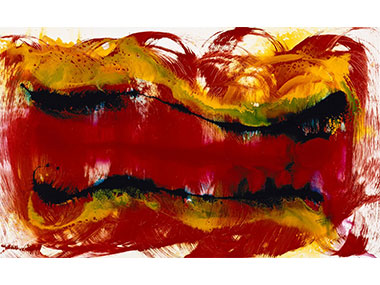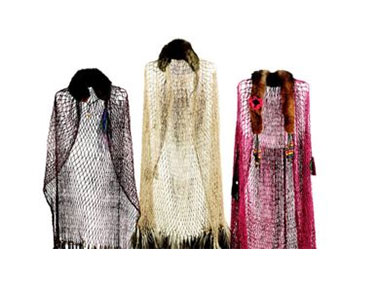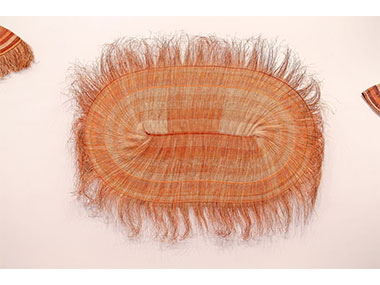Melbourne Does Indigenous

Samantha Hobson's 'Bust 'im up' (2000), a very colourful synthetic polymer paint on canvas from one of the Lockhart Gang on Cape York - at the NGV
Posted by Jeremy Eccles | 16.12.16
Dates:
16.12.16
: 09.04.17
Overnight, Melbourne is the centre of the Australian Indigenous universe with two substantial shows opening today - one of them a first-ever appearance of Aboriginal art at the defiantly non-Indigenous Australian Centre for Contemporary Art (ACCA). One has to ask, Did they coordinate with the NGV which opens its own show, Who’s afraid of colour? on the same day? And is this all preparing the way for Yirramboi, the First Nations Arts Festival in Melbourne next May which “aims to deeply engage the local Aboriginal community while extending an invitation to First Nations artists and communities across the country and the world”.
Any room for non-Indigenous persons, I wonder?
Or men – for the show opening at the NGV is women only – 118 of them!
A new Artistic Director at ACCA, Max Delaney seems responsible for the Indigenous breakthrough in its rusted steel building on Southbank. But no one can complain that he's not continuing to be utterly 'contemporary' – for none of the artists comes from north of the Murray. Victoria does like to celebrate its own.
And with the title, 'Sovereignty', Delaney is not mincing his words in the catalogue in giving it a political purpose: “At present, Australia’s federal government is leading ‘a move towards recognising Aboriginal and Torres Strait Islander peoples in Australia’s founding document – our Constitution', with a Referendum Council established to ‘consult widely throughout Australia’ and to ‘inform a model to take to a referendum’ on constitutional change. For First Nations people, however, the Constitution itself is a compromised, illegitimate document, built on the lie and legal fiction of terra nullius. Many in the Indigenous community are increasingly opposed to the principle of constitutional recognition, rejecting the idea of seeking recognition from white Australia within an imposed colonial framework, one that impinges upon Indigenous sovereignty. Not wanting to ‘tinker with white man’s constitution’, as Dhudhuroa Elder and Traditional Owner Gary Murray has put it, First Nations Australians are instead seeking recognition ‘as sovereign people’ through a process of negotiation between parties leading to a settlement or treaty”.
I wonder what the great Kulin Nation leader, William Barak would have thought – for his work from the 19th Century is being co-opted into this politico-scene. More than 30 living artists are also involved, including Brook Andrew, Lisa Bellear, Jim Berg, Briggs, Trevor ‘Turbo’ Brown, Maree Clark, Amiel Courtin-Wilson & Uncle Jack Charles, Megan Cope, Vicki Couzens, Destiny Deacon & Virginia Fraser, Marlene Gilson, Korin Gamidji Institute, Brian Martin, Bruce McGuinness, Kent Morris, Steaphan Paton, Reko Rennie, Steven Rhall and the WAR group (Warriors of the Aboriginal Resistance). The late Bill Onus, father of artist Lin and an early pioneer of Aboriginal rights features in photographs and rarely seen super 8 films from his home movie collection, c.1964. The films capture everyday life and activities at Bill Onus’ Aboriginal Enterprises; a family road trip across the Nullabor; Lin Onus painting a mural; and Bill throwing a boomerang with Harry Belafonte and Pastor Doug Nicholls.
So plenty of context, and a bit of entertainment from hip-hopper Briggs – who was recently subject to racist abuse for 'calling-out' audience members who'd turned up in black-face! Black-face is, of course, the mode in which photographer Bindi Cole dressed up her family to mock the notion that you have to look black to be an Aboriginal person! Oddly, Cole is missing from this show but appears in the NGV.
Also, oddly, in such a political event, there are a number of contemporary craft works – possum-skin cloaks, baskets and fish-nets that might seem to represent the domestic work of women past. Fortunately, Paola Balla (Wemba-Wemba and Gunditjmara), co-curating collaboratively with Max Delany puts me straight in the catalogue: “Vicki Couzens, Bronwyn Razem, Maree Clarke and Glenda Nicholls are artists who demonstrate deep knowledge through finely crafted artistic practices that are at once poetic and political. In speaking back to the violence, oppression and subjugation of Aboriginal women, they make work that is powerful, healing and breathtakingly beautiful. Within Sovereignty, we see a matriarchal space and the work of women woven throughout the narrative of the exhibition, from the depiction of events in Marlene Gilson’s history paintings of Batman’s ‘treaty’ with the Wurundjeri of the Kulin Nation, and her moving depiction of the public execution of Tunnerminnerwait and Maulboyheenner, to Megan Cope’s inverted protest placards in which she subverts the explicit and disturbing racism expressed by white Australia on a daily basis, particularly through social and mainstream media”.
'Sovereignty' challenges at ACCA until 26th March.
Meanwhile, over at the NGV, the women have a monopoly of colour. Or do they? For, in a show (curated by Judith Ryan) called Who's Afraid of Colour?, some of my favourite works clearly lack it. There are the black baskets of Margaret Rarru, for instance, the restrained ochres of the Yunupingu sisters and of the Tiwi Islands' Jean Baptiste Apuatimi (in a really beautiful quartet of canvases), and, of course, the amazing 8 metres of entangled black and white roots in Emily Kngwarreye's never-ending 'Big Yam'.
Judith Ryan finds a less-political and more arty explanation for her inclusion of a whole raft of fibre works in her show: “Indigenous weaving also experienced a dramatic resurgence during these decades (the late 80s and 90s). The fibre art movement has empowered and brought acclaim to a host of women artists working in radically different locales. It encompasses the major work of sedge weavers in the South East led by Yvonne Koolmatrie and women such as Lorraine Connelly-Northey who are creating extraordinary sculptural installations with found materials; the fish traps, dilly bags, nets and basketry sculptures of pandanus weavers in Arnhem Land and Queensland, fibre art of the Torres Strait, as well as the fantastic creations of Tjanpi Desert Weavers. Owing to the individual weavers’ considerable commitment, this customary medium has been transformed into an innovative art form. Woven objects are no longer marginalised as handicrafts but are nationally and internationally marketed as contemporary fine art”.
And when you see Helen Guyupul's simple String Bag, mutating through a delicious tonal range from dark green to delicate yellow (all natural dyes); Mary Mutumurruwuy's spider's web fish net; or Elizabeth Djutarra's sun-bright woven mat (illustrated) it's impossible to deny artistry.
While ACCA has commissioned much of its exhibition, the NGV has been collecting for years. So it can produce historic collections of artists such as Queenie McKenzie, Lorna Fencer or Emily Kngwarreye – in the latter case, going back into her Utopia community's batik-making origins. There's even earlier work from the pioneering at centre at Ernabella. And strange Warlpiri pottery.
Interestingly, the good ol' politics of 'traditional' versus Western-trained artists inadvertently raise their head in Ryan's catalogue essay. At one point she lauds the “use (of) the language of their generation and reference (to) the international language of art to express the politics of their identity or to comment on issues of universal concern” by urban artists such as Destiny Deacon, Bindi Cole Chocka, Yhonnie Scarce, Jenny Crompton, Julie Dowling, Judy Watson, Julie Gough, Sandra Hill and Maree Clarke. Later, Ryan “challenges the viewer to look beyond stereotypes of Indigenous art practice and to reconsider narrow definitions of Contemporary art that privilege artists with western art school training over those like Kitty Kantilla, Maryanne Mungatopi or Queenie McKenzie who prefer to use customary materials and/or inherited iconography to express the poetics of mourning or their affinity with Country”.
A celebration of diversity? Or just difference?
That's a debate which ain't going to go away – and how splendid to have it there, spread out around Melbourne's Southbank throughout the summer to stimulate thought
.
And don't forget the Yirramboi Festival in May.
URL: http://www.accaonline.org.au
Share this:
»  del.icio.us
»
del.icio.us
»  Digg it
»
Digg it
»  reddit
»
reddit
»  Google
»
Google
»  StumbleUpon
»
StumbleUpon
»  Technorati
»
Technorati
»  Facebook
Facebook
Contact Details

A trinity of cloaks at ACCA - Glenda Nicholls has woven what she calls 'Acknowledgement, Seniors and Welcome cloaks' (2016)

Probably the most ancient form in Melbourne - Elizabeth Djutarra's Woven Floor mat (1991), made from natural dyed pandanus fronds, shwoing at the NGV
Further Research
Artists: Bindi Cole Chocka | Barrupu Yunupingu | Brian Martin | Briggs | Bronwyn Razem | Brook Andrew | Bruce McGuinness | Destiny Deacon | Elizabeth Djutarra | Emily Kngwarreye | Glenda Nicholls | Gulumbu Yunupingu | Helen Guyupul | Jean Baptiste Apuatimi | Jenny Crompton | Jim Berg | Judy Watson | Julie Dowling | Julie Gough | Kent Morris | Kitty Kantilla | Korin Gamidji Institute | Lin Onus | Lisa Bellear | Lorna Fencer | Lorraine Connelly-Northey | Maree Clark | Maree Clarke | Margaret Rarru | Marlene Gilson | Mary Mutumurruwuy | Maryanne Mungatopi | Megan Cope | Nayapanyapa Yunupingu | Queenie McKenzie | Reko Rennie | Sandra Hill | Steaphan Paton | Steven Rhall | Tjanpi Desert Weavers | Trevor ‘Turbo’ Brown | Vicki Couzens | WAR Group | William Barak | Yhonnie Scarce | Yvonne Koolmatrie
News Tags: Aboriginal treaty | ACCA | Bill Onus | Colour | Jeremy Eccles | Judith Ryan | Max Delaney | Melbourne | NGV | Paula Balla | Sovereignty | Yirramboi Festival
News Categories: Australia | Blog | Event | Exhibition | Feature | Festival | Industry | News
Exhibition Archive
- 10.10.17 | TARNANTHI 2017
- 11.08.17 | Natsiaas 2017
- 20.07.17 | APY ART DOMINATES THE WYNNE
- 17.07.17 | Anangu Artist Wins $100,000 Prize
- 14.07.17 | The End of AAMU
- 11.07.17 | ART ACROSS THE COUNTRY
- 11.07.17 | TARNANTHI IN OCTOBER
- 05.07.17 | TJUNGUṈUTJA - from having come together
- 13.06.17 | Ghost-Nets Straddle the World
- 07.06.17 | Grayson Perry Going Indigenous?
- 05.06.17 | Barks Bigger than Ben Hur
- 27.05.17 | NGA QUINQUENNIAL 2017
- 21.05.17 | Blak Douglas Finds Home at the NGA
- 21.05.17 | BRIAN ROBINSON WINS HAZELHURST WOP
- 18.05.17 | PARRTJIMA 2.0
Advertising

